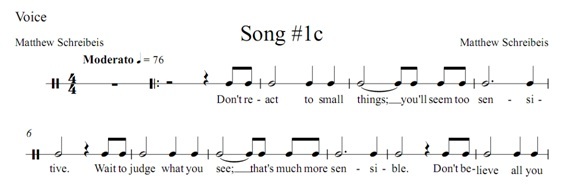|
The presentation reported a small-scale pilot study regarding
the influence of melodic structure on second language learners’ ability
to allocate attention (i.e., noticing) to target vocabulary. The
research project was designed and implemented via an interdisciplinary
collaboration between an SLA researcher/teacher educator and a classical
music composer/theorist. This research was motivated by language
teachers’ anecdotes of using music in their class in order to lower
their students’ anxiety and help them to remember vocabulary.
Teachers’ experiences of using music are often mixed. In this
research, we examined task-specific melodies and their influence on
second language learners’ ability to remember target vocabulary. Three
groups of students learned three different songs. The first group
learned target vocabulary with melodies featuring an ascending diatonic
major key melodic structure. The melodies used for the second group
lacked a discernible pitch hierarchy. The control group received
instruction using rhythmic speaking without pitch. The target vocabulary
was synforms (Laufer, 1988). Second language learners found synforms
quite difficult to learn; examples of synforms, which share some
affixes, are sensitive, sensible, credible, credulous, and intelligible
and intelligent. Part of these songs is below:
Group 1:

Group 2:

Group 3:

The following graphs show the musical structures used for Group 1 and Group 2:

(MG1: Music group 1, MG2: Music group 2)
As indicated in MG1’s graph (yellow line), Group 1’s music
shows ascending melodic stucture. In contrast, MG2 does not show any
discernable structures.
The results revealed that learners who were exposed to the
target vocabulary through a melody whose structure reflected the
ascending major scale outperformed other groups that received melodies
that lacked a discernible pitch hierarchy or music without the element
of pitch in terms of allocating their attention (i.e., noticing target
vocabulary). That is, those who learned target vocabulary through
ascending diatonic major key melodic structure remembered the vocabulary
when they were asked to fill in blanks after the task.
This presentation was successful in attracting a diverse
audience: It was composed of former performers who had changed their
careers, ESL instructors looking for innovative teaching methods,
administrators, and students working on their master’s theses. Audience
members asked a range of questions regarding the rationale of choosing
particular melodic structures as well as the theoretical framework of
the research.
Based on the audience’s positive comments and strong interest
in using music in the language classroom, we hope to expand this
research project with more participants and provide a longer study
period. We strongly believe that the end product will be helpful for
language teachers to choose more efficient music for language
learning.
REFERENCES
Laufer, B. (1988). The concept of ‘synforms’(similar lexical
forms) in vocabulary acquisition. Language and Education,
2(2), 113–132.
Jiyoon Lee’s research and teaching interests
include second language acquisition, language assessment, task-based
language teaching, and curriculum development. She teaches practical as
well as theoretical courses on second language acquisition and teaching.
She also conducts workshops on content-based
learning for secondary school teachers in the Philadelphia community and
assessment for higher education foreign language instructors abroad.
Having presented at various academic conferences in the United States,
in Korea, and in the United Kingdom, she has published in the TESOL Quarterly (solo author), Language
Testing (with Butler), Modern Language
Journal (with Butler), English Today (with
Jeon), Working Papers in Educational Linguistics, and Electronic Magazine for Multicultural Education.
More information can be found at: https://sites.google.com/site/jylee0515/
The music of composer Matthew Schreibeis, which
includes electronic and acoustic works, as well as music for Western and
Korean instruments, combines highly syncopated counterpoint with
rhythmically charged lyricism. His works have been performed throughout
the United States, Germany, Switzerland, and Korea. Honors include
grants from the American Composers Forum and University of Pennsylvania,
commissions from the Hanson Institute for American Music and the
University of Nevada Las Vegas, residencies at Yaddo and Virginia Center
for Creative Arts, and 1st Prize in the National Association of
Composers USA Young Composers Competition. He received degrees from the
Eastman School of Music (BM) and the University of Pennsylvania (PhD),
where he is currently lecturer. He has also served as a visiting
professor at Korea University in Seoul.
https://sites.google.com/site/mschreibeis/ | 
